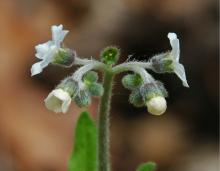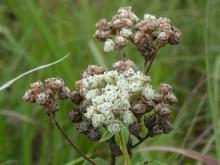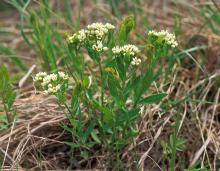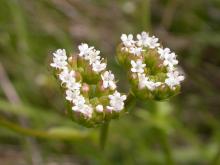Wildflowers, Grasses and Other Nonwoody Plants
Media

Species Types
Scientific Name
Tephrosia virginiana
Description
Two-colored flowers of pink and light yellow make goat's rue easy to identify. Look for this legume in rocky, open woods, savannas, prairies, glades, and fields.
Media

Species Types
Scientific Name
Lathyrus latifolius
Description
Everlasting pea is an old-fashioned garden plant your grandma might have grown on a fence. Native to the Old World, it often persists at old homesites.
Media

Species Types
Scientific Name
Scutellaria incana
Description
Showy clusters of blue-violet, two-lipped flowers adorn downy skullcap. This native mint is found mostly in the southern half of the state.
Media

Species Types
Scientific Name
Tradescantia longipes
Description
Dwarf spiderwort is a low-growing perennial with bright magenta, purple, or purplish-blue flowers with three petals arranged in a triangular pattern. It blooms in Ozark woodlands in April and May.
Media

Species Types
Scientific Name
Cynoglossum virginianum
Description
Wild comfrey has large basal leaves that are soft, hairy, and elliptical with long petioles — they look like hounds’ tongues! The upright flowering stalk has few leaves and looks like a wand.
Media

Species Types
Scientific Name
Parthenium integrifolium
Description
A common component of high-quality upland prairie, American feverfew, or wild quinine, is a native wildflower that was used to treat fevers or malaria. It's in the composite family.
Media

Species Types
Scientific Name
Nothoscordum bivalve
Description
False garlic looks like a wild garlic or onion plant, but it doesn’t smell like one. The flowers can be white, yellowish, or greenish, and they appear in spring and sometimes also fall.
Media

Species Types
Scientific Name
Antennaria parlinii
Description
Plainleaf pussytoes, named for its fuzzy flower heads, is one of the few flowering plants in Missouri that grows well in dry and shaded areas. It’s also an indicator of acid soils.
Media

Species Types
Scientific Name
Comandra umbellata (formerly C. richardsiana)
Description
Bastard, or false toadflax is one of the hundreds of wildflowers that bejewel our native prairies. A perennial herb with yellowish-green foliage and smooth, upright stems, it grows and flowers under the hottest conditions.
Media

Species Types
Scientific Name
Valerianella radiata
Description
At first glance, you might overlook corn salad, except for the large colonies it often forms. The young leaves can be eaten as a salad green, hence the name.
See Also
About Wildflowers, Grasses and Other Nonwoody Plants in Missouri
A very simple way of thinking about the green world is to divide the vascular plants into two groups: woody and nonwoody (or herbaceous). But this is an artificial division; many plant families include some species that are woody and some that are not. The diversity of nonwoody vascular plants is staggering! Think of all the ferns, grasses, sedges, lilies, peas, sunflowers, nightshades, milkweeds, mustards, mints, and mallows — weeds and wildflowers — and many more!





















